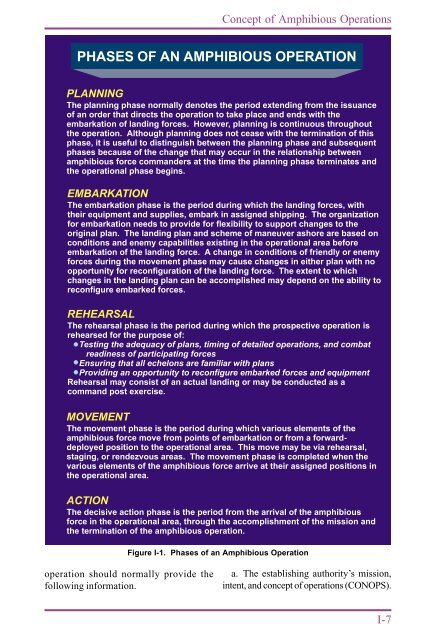Joint Doctrine for Amphibious Operations - Historic Naval Ships ...
Joint Doctrine for Amphibious Operations - Historic Naval Ships ...
Joint Doctrine for Amphibious Operations - Historic Naval Ships ...
- No tags were found...
You also want an ePaper? Increase the reach of your titles
YUMPU automatically turns print PDFs into web optimized ePapers that Google loves.
Concept of <strong>Amphibious</strong> <strong>Operations</strong>PHASES OF AN AMPHIBIOUS OPERATIONPLANNINGThe planning phase normally denotes the period extending from the issuanceof an order that directs the operation to take place and ends with theembarkation of landing <strong>for</strong>ces. However, planning is continuous throughoutthe operation. Although planning does not cease with the termination of thisphase, it is useful to distinguish between the planning phase and subsequentphases because of the change that may occur in the relationship betweenamphibious <strong>for</strong>ce commanders at the time the planning phase terminates andthe operational phase begins.EMBARKATIONThe embarkation phase is the period during which the landing <strong>for</strong>ces, withtheir equipment and supplies, embark in assigned shipping. The organization<strong>for</strong> embarkation needs to provide <strong>for</strong> flexibility to support changes to theoriginal plan. The landing plan and scheme of maneuver ashore are based onconditions and enemy capabilities existing in the operational area be<strong>for</strong>eembarkation of the landing <strong>for</strong>ce. A change in conditions of friendly or enemy<strong>for</strong>ces during the movement phase may cause changes in either plan with noopportunity <strong>for</strong> reconfiguration of the landing <strong>for</strong>ce. The extent to whichchanges in the landing plan can be accomplished may depend on the ability toreconfigure embarked <strong>for</strong>ces.REHEARSALThe rehearsal phase is the period during which the prospective operation isrehearsed <strong>for</strong> the purpose of:Testing the adequacy of plans, timing of detailed operations, and combatreadiness of participating <strong>for</strong>cesEnsuring that all echelons are familiar with plansProviding an opportunity to reconfigure embarked <strong>for</strong>ces and equipmentRehearsal may consist of an actual landing or may be conducted as acommand post exercise.MOVEMENTThe movement phase is the period during which various elements of theamphibious <strong>for</strong>ce move from points of embarkation or from a <strong>for</strong>warddeployedposition to the operational area. This move may be via rehearsal,staging, or rendezvous areas. The movement phase is completed when thevarious elements of the amphibious <strong>for</strong>ce arrive at their assigned positions inthe operational area.ACTIONThe decisive action phase is the period from the arrival of the amphibious<strong>for</strong>ce in the operational area, through the accomplishment of the mission andthe termination of the amphibious operation.Figure I-1. Phases of an <strong>Amphibious</strong> Operationoperation should normally provide thefollowing in<strong>for</strong>mation.a. The establishing authority’s mission,intent, and concept of operations (CONOPS).I-7
















